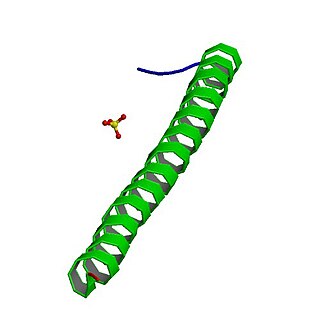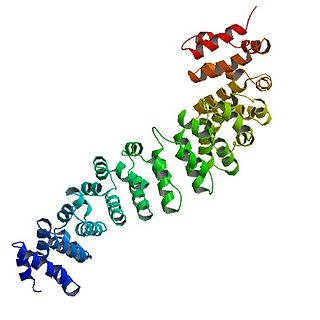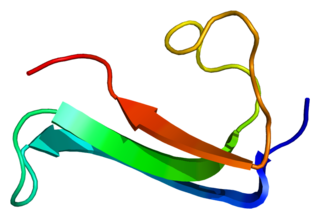The Wnt signaling pathways are a group of signal transduction pathways which begin with proteins that pass signals into a cell through cell surface receptors. The name Wnt is a portmanteau created from the names Wingless and Int-1. Wnt signaling pathways use either nearby cell-cell communication (paracrine) or same-cell communication (autocrine). They are highly evolutionarily conserved in animals, which means they are similar across animal species from fruit flies to humans.

Adenomatous polyposis coli (APC) also known as deleted in polyposis 2.5 (DP2.5) is a protein that in humans is encoded by the APC gene. The APC protein is a negative regulator that controls beta-catenin concentrations and interacts with E-cadherin, which are involved in cell adhesion. Mutations in the APC gene may result in colorectal cancer and desmoid tumors.

Catenin beta-1, also known as β-catenin (beta-catenin), is a protein that in humans is encoded by the CTNNB1 gene.

Midkine, also known as neurite growth-promoting factor 2 (NEGF2), is a protein that in humans is encoded by the MDK gene.

B-cell lymphoma 3-encoded protein is a protein that in humans is encoded by the BCL3 gene.

Axin-2, also known as axin-like protein (Axil), axis inhibition protein 2 (AXIN2), or conductin, is a protein that in humans is encoded by the AXIN2 gene.

Receptor-type tyrosine-protein phosphatase PCP-2, is an enzyme that in humans is encoded by the PTPRU gene.

Transcription factor 7 is the gene that in humans encodes for the TCF1 protein.

Receptor-type tyrosine-protein phosphatase kappa is an enzyme that in humans is encoded by the PTPRK gene. PTPRK is also known as PTPkappa and PTPκ.

Proto-oncogene FRAT1 is a protein that in humans is encoded by the FRAT1 gene.

Epithelial membrane protein 3 (EMP3) is a trans-membrane signaling molecule that is encoded by the myelin-related gene EMP3. EMP3 is a member of the peripheral myelin protein gene family 22-kDa (PMP22), which is mainly responsible for the formation of the sheath of compact myelin. Although the detailed functions and mechanisms of EMP3 still remain unclear, it is suggested that EMP3 is possibly epigenetically linked to certain carcinomas.

Protein CBFA2T3 is a protein that in humans is encoded by the CBFA2T3 gene.

Pygopus homolog 2 is a protein that in humans is encoded by the PYGO2 gene.

MAD2L1-binding protein is a protein that in humans is encoded by the MAD2L1BP gene.

B-cell CLL/lymphoma 9 protein is a protein that in humans is encoded by the BCL9 gene.

αE-catenin, also known as Catenin alpha-1 is a protein that in humans is encoded by the CTNNA1 gene. αE-catenin is highly expressed in cardiac muscle and localizes to adherens junctions at intercalated disc structures where it functions to mediate the anchorage of actin filaments to the sarcolemma. αE-catenin also plays a role in tumor metastasis and skin cell function.

Transmembrane protein 158 is a protein that in humans is encoded by the TMEM158 gene.

Tetraspanin-12 (Tspan-12) also known as tetraspan NET-2 (NET2) or transmembrane 4 superfamily member 12 (TM4SF12) is a tetraspanin protein that in humans is encoded by the TSPAN12 gene. Tetraspanin-12 is found in the membrane of a variety of cells. It has an unusually long C-terminal intracellular tail of approximately 60 amino acids.

In molecular biology, deleted in lymphocytic leukemia 1 , also known as DLEU1, is a long non-coding RNA. In humans it is located on chromosome 13q14. The DLEU1 gene was originally identified as a potential tumour suppressor gene and is often deleted in patients with B-cell chronic lymphocytic leukemia. It was later discovered to be a long non-coding RNA with over 20 different splice variants.

Dishevelled binding antagonist of beta catenin 2 is a protein that in humans is encoded by the DACT2 gene.




















